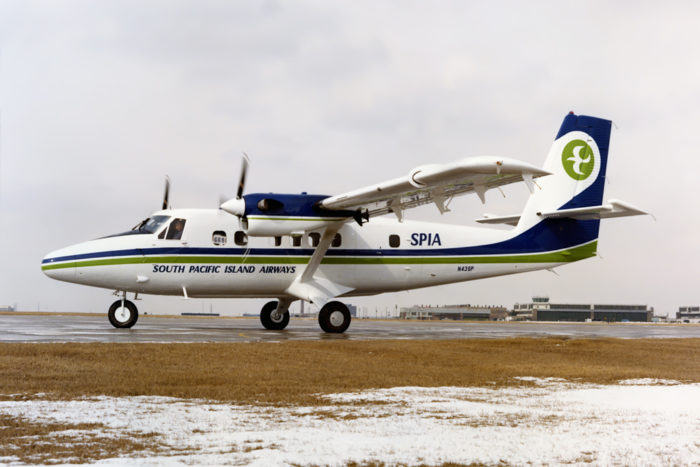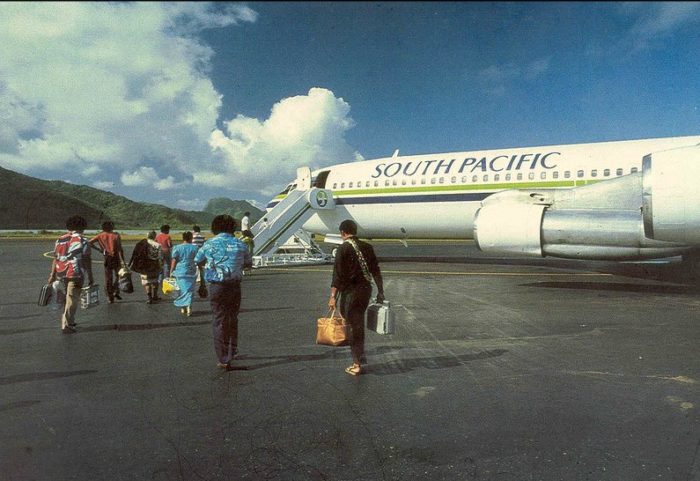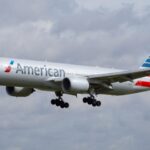I Know … Let’s Start an Airline!
Some 25 or so years ago, George Wray had a one-man law practice in Pago Pago, American Samoa. George was a pilot as well as a lawyer and often flew his own plane to meet with clients in Apia, the capital city of Western Samoa, an independent nation just a 30-minute flight away. George made the trip so frequently that people began asking him if they could catch a ride. So George said, “I think I’ll start an airline.”

He acquired a twin engine Otter—leased it, I suppose—hired a couple of pilots, and started flying locals back and forth between the two towns. And South Pacific Island Airways was born.
Samoans had barely gotten used to the idea of having their own airline when George
leased a Boeing 707 and began regular flights between Pago Pago and Honolulu. This was another bold—some said foolhardy—move because it put George in direct competition with Continental Airlines which was then flying that route.
At first, Continental viewed the competition from SPIA with disdain. After all, their airline was serving Pago Pago with modern DC-10’s, while by that time the 707s were considered to be virtually obsolete by the major airlines.
“George will never make it,” Stan Kennedy, Continental’s man in Honolulu told me. “Our DC-10s are much more fuel efficient and they carry twice as many people.”
Wray laughed when I relayed Kennedy’s remark. “But we’re both averaging just over 100 passengers per flight,” he said. “The DC-10 can carry more than 200 passengers and they lose money if the flight is half full, but a hundred passengers is a profitable flight for me.”

Within months, George leased two more 707s and began flights to Tahiti and Guam. It was often a struggle, however, and on more than one occasion, passengers waited in a departure lounge while George ran around Honolulu raising enough money to pay for jet fuel.
SPIA’s inevitable demise came as the result of two events, either of which would have probably been fatal. First, there was a slew of negative publicity when the FAA grounded SPIA because a pilot flew a charter over the pole to Europe despite the failure of a required piece of navigational equipment. And, at about the same time, Hawaiian Airlines aggressively entered those same markets.
Still, I liked George immensely and to this day I wonder how a lawyer, working from a small office in Pago Pago, American Samoa, could wake up one morning and say, “I think I’ll start an airline.” And then do it!




I worked for George Wray at SPIA from April 6, 1977 to February 14, 1978 as a pilot. At that time SPIA was flying Cessna 402’s (N41SP, N3SP), a Britten-Normand (N2000J) Islander and a DeHavilland Twin Otter (N23BC). This was a pretty exciting job for a low time (200 hours twin engine time, 1400 total) pilot like myself. A fellow pilot Mike Egan and I met Milt Woods, the Chief Pilot, during his ferry flight to Samoa with the Twin Otter. Mike and I were both flying out of Honolulu at the time, within months, Milt hired both of us. Milt and George ran a grueling flight operation, I worked for SPIA for 314 days and flew 259 of those and logged 1399.4 hours of flight time, averaging 140 hours a month. No real complaints, Mike and I were building valuable time and discovering the extremes of our abilities. Because of this SPIA could not hold on to pilots very long. There were four of us that managed to hang in there, Milt Woods, Mike Egan, Bill Deems and myself for the time I was there. Others came and left in short order, Bill Arnold, Dick Leal and Jim Rasback, they were not willing to put up with the schedules, the weather, and unrealistic demands put on them. We flew into very short airstrips, long distances, overweight, over water (316 miles Pago Pago to Vavau), and with little navigation. We navigated via a commercial radio station beam on our ADF’s and hoped it lined us up with the intended destination, then we would hopefully find the island on our radar, if it was working.
Once I had the hours to take my ATP (Airline Transport Pilot) exam, I needed five days to fly up to Honolulu for the written, the company refused to let me go, so I resigned. The pilot that replaced me, I met once before I left, crashed one of the C-402’s into the top of the mountain during a non-existent NDB (no DME, no descent allowed until over water), decent into APW, in Western Samoa, it took a week to get to the wreckage. Once, we were very familiar with the terrain under VFR conditions, we were prone to modify some of the approaches.
Not sure where this is going, but SPIA was great for me, got lots of experience and time, but we did unprofessional things in pursuit of our careers, at SPIA you did not make waves, you did what you were told and hoped your luck and abilities carried you to see another day! But, but, but, but, was it fun and exciting. I could continue writing for hours, plus I have lot’s of photos from that time.
The joys of living in paradise. George Wray, RIP. I did go on to have a great aviation career.
Brian Guerin
My father, Stan Fichtman, adored George Wray. He and George went back to the first days that SPIA flew their 707’s to Honolulu. The were serviced by Aloha ground ops, which my father oversaw as part of his duties as VP of Maintenance at Aloha (1977-1984). My father thought the man was brilliant and really dig’d the whole sense of adventure thing that George imparted on him.
It was so much that my father would work for George in the final inter nation of SPIA from 1985-1986. I remember how my father got the call to work for George and get the airline back in the air. And by golly, after what I consider to be a miracle, the airline made it back in the air. I say this in consideration that George got back into the air as a paraplegic, after suffering a diving accident in the early 80’s while operating the first inter nation of SPIA.
Albeit, it didn’t last long, but that brief time my father worked with George that sense of adventure is what really drove him and the airline. The whole operation was a scrappy seat of your pants type of thing that really was the last gasp of how airlines operated before MBA’s and profit centered accountants took over the entire industry.
If it were still operating today, it’d be seen as a dinosaur of a time long gone. But for those who were part of it, despite the trust factor (which my Mom frequently pointed out to my father throughout all this) it was an adventure.
And despite the trust factor of George, you mention his name to a certain generation of American Samoans, and you tell them your relationship – well, lets just say that you are considered part of the family in some cases, as I recently experienced.
Very interesting article. I was a pilot for SPIA in 1976. The story I heard was that George was working as a lawyer in Pago Pago when he found out he could get free tickets on PanAm if he had an airline. He bought a Cherokee 6 on floats, started SPIA and got his free tickets. When I worked there SPIA had two Cessna 402’s and a BN Islander. George was not easy to work for. He had a problem with telling the truth which caused serious problems with the FAA in Hawaii, the office that oversaw SPIA. I was there only a few months. After leaving I was amazed when I heard he leased a B-707!
I hadn’t heard the story about the free PanAm tickets, but it certainly rings true. At one point, the SPIA “fleet” consisted of three B-707s and George was flying to Guam and Tahiti in addition to Pago Pago. Great fun to hear from you!
I worked for George in 1971, as manager of South Seas Airways. Our Cherokee 6 on floats made a daily flight to Ofu Island at high tide. The plane was nick named “Paopao Lele.” I was 24 years old and just out of college. I really enjoyed working with George. My time there was quite an education.